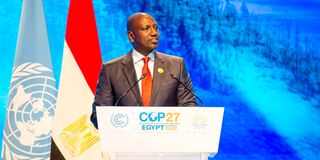Climate action key to sustainable growth

President William Ruto addressing the COP27 meeting in Sharm El-Sheikh, Egypt. Ruto's call to increase forest cover to 30 per cent by planting 15 billion trees by 2032 will be a game-changer for Kenya.
Climate change has had adverse effects on our communities. It has hampered productive sectors and worsened poverty. Unpredictable rainfall patterns, for example, have weakened agricultural productivity across Africa.
This is why President William Ruto’s call to increase forest cover to 30 per cent by planting 15 billion trees by 2032 will be a game-changer for Kenya. The country’s voice during the United Nations General Assembly (UNGA) as well as COP27 has positioned it as a world champion on climate action.
To achieve the goal of 30 per cent forest cover, every Kenyan must grow more than 300 tree seedlings in the next decade. This would also push the country closer to realising the objectives set out in the Kenya Vision 2030, the bottom-up economic blueprint and the United Nations Sustainable Development Goals (SDGs) 1, 2, 3, 6, 11, and 13 respectively on reducing poverty, eliminating hunger, promoting the wellbeing of the people, water for all, sustainable cities and communities, and climate action.
The degradation of Kenya’s water towers has created a severe shortage of quality and adequate water for our households, towns and cities.
Major towns as well as rural areas are facing an acute shortage of water, thus threatening crucial sectors of the economy. Water and sanitation is a critical economic enabler. Many if not all nation states were formed around rivers or water catchment areas. And indeed many Kenyan cities and towns have also emerged near major waterways, rivers and catchment areas.
Kisumu, Mombasa and Eldoret, for example, emerged as a result of Lake Victoria, the Indian Ocean and ‘Saucy Annie’ or Sosiani river.
Women, girls, children, the elderly and people with disabilities bear the brunt of climate change. Climate action, most profoundly increasing the forest cover, is expected to increase the quality and quantity of water for our communities in rural and urban Kenya.
Concerted efforts
Focusing on the realisation of SDG17 — the need to forge local and global partnerships for development — is critical. The government cannot realise this without concerted efforts by socially responsible corporates, philanthropists, local and international NGOs, civil society, schools, colleges, private sector organisations and global partners.
A collaborative framework should be created to harness all the social investments in Kenya, as part of deliberate efforts to create the Kenya we want.
Therein lies an opportunity for a bottom-up conservation effort that would increase Kenya’s forest cover while at the same time accelerating the pace of local economic development. As patriots, we owe it to Kenya to inject our resources from wherever we are in making the 30 per cent forest cover a reality before 2032. I urge every compatriot to rally behind the government and help secure the future of our country.
Mr Biwott is the MD, Eldoret Water and Sanitation Company Ltd (Eldowas). [email protected].





